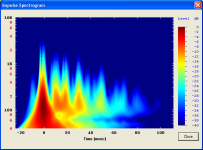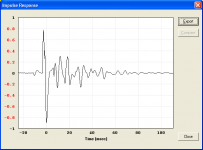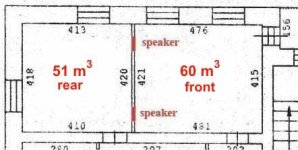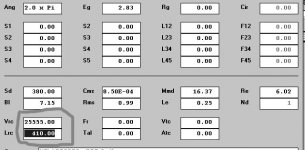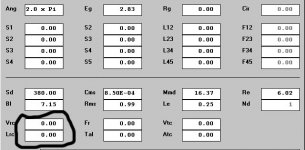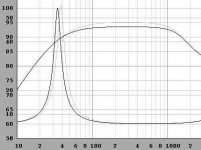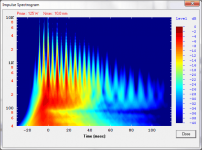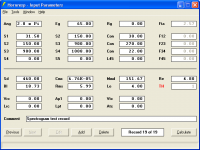Hornresp Version 27.00
Hi Everyone,
Hornresp Version 27.00 has just been released. Changes are:
1. An Impulse Spectrogram tool has been added. The tool is accessed from the SPL Response window using the Tools > Impulse > Spectrogram menu command. See the example output attached. My thanks to Jean-Michel (Jmmlc) for kindly providing the necessary code for the spectrogram calculation routines.
2. The format of the Impulse Response tool has been revised. See attachment 2.
3. The currently specified values of Pmax and Xmax are now auto-loaded into the Loudspeaker Wizard, as requested by GM in Post #1178. The Wizard Pmax and Xmax slider values are now also transferred back to the main program when the Wizard is closed by clicking the Save button. Note that it is still necessary to press Ctrl+S from the Maximum SPL tool to permanently save the transferred values to the data record. Double-click the Pmax slider label to activate / deactivate the Pmax and Xmax sliders - there is a 'prompt' message to this effect displayed above the disabled Pmax slider.
4. The fatal run-time error reported by GM in Post #1186 has been fixed.
Kind regards,
David
Hi Everyone,
Hornresp Version 27.00 has just been released. Changes are:
1. An Impulse Spectrogram tool has been added. The tool is accessed from the SPL Response window using the Tools > Impulse > Spectrogram menu command. See the example output attached. My thanks to Jean-Michel (Jmmlc) for kindly providing the necessary code for the spectrogram calculation routines.
2. The format of the Impulse Response tool has been revised. See attachment 2.
3. The currently specified values of Pmax and Xmax are now auto-loaded into the Loudspeaker Wizard, as requested by GM in Post #1178. The Wizard Pmax and Xmax slider values are now also transferred back to the main program when the Wizard is closed by clicking the Save button. Note that it is still necessary to press Ctrl+S from the Maximum SPL tool to permanently save the transferred values to the data record. Double-click the Pmax slider label to activate / deactivate the Pmax and Xmax sliders - there is a 'prompt' message to this effect displayed above the disabled Pmax slider.
4. The fatal run-time error reported by GM in Post #1186 has been fixed.
Kind regards,
David
Attachments
great! I'll install tonight.. 27.00 ..
#1219 again, more detailed 
attachments:
1. speakers will be in IB, wall mounted. rear room 51m^3, front (listening) room60m^3.
the same driver in 2pi:
2. input (gray graphs in 4) - with 22222 litres rear chamber(its half ov rear room volume)).
3. input (black graphs in 4) - w\o rear chamber.
4. spl & imp. comparison.
can anybody comment this graphs - spl difference at hundreds hz, lower Qt with rear chamder ?
and will roughly the same listening room in front of driver produce similar effect?
attachments:
1. speakers will be in IB, wall mounted. rear room 51m^3, front (listening) room60m^3.
the same driver in 2pi:
2. input (gray graphs in 4) - with 22222 litres rear chamber(its half ov rear room volume)).
3. input (black graphs in 4) - w\o rear chamber.
4. spl & imp. comparison.
can anybody comment this graphs - spl difference at hundreds hz, lower Qt with rear chamder ?
and will roughly the same listening room in front of driver produce similar effect?
Attachments
Last edited:
Wow the spectrogram is awesome!
I like how fast it renders, my endeavors in Octave took considerable longer to complete.
Would there be any way to set the range in ms to make comparison between graphs possible?
Is there any way you two could make it into a separate app that imports wav files?
Hard to find any other way that would be more user friendly.
This is going to keep me up all night.
Thanks guys, what you do for this hobby means a lot to us.
I like how fast it renders, my endeavors in Octave took considerable longer to complete.
Would there be any way to set the range in ms to make comparison between graphs possible?
Is there any way you two could make it into a separate app that imports wav files?
Hard to find any other way that would be more user friendly.
This is going to keep me up all night.
Thanks guys, what you do for this hobby means a lot to us.
Last edited:
I like how fast it renders, my endeavors in Octave took considerable longer to complete.
Apparently your computer is a lot faster than mine, I took a mid-morning break while it calc'd it.
GM
The two room chambers combined with the stairwell will create a 4th order BP with an expanding vent, so a fairly complex system to sim once one factors in whatever the stairwell dumps into and even then a speaker program will assume you're located a meter away from where it terminates in the next chamber.
Anyway, as a crude approximation, if the volume (Vb) of the rear chamber is ~the same as the front chamber, then from a driver loading 'point of view' (POV) it's an acoustically large dipole, i.e. the diaphragm is 'feeling' ~the same acoustic load on both sides of it.
If both chamber Vbs are acoustically large enough referenced to the driver's Vas (or the sum of them if multiple drivers), then this air mass load will in theory lower the driver's Fs, Qts a bit, though no where near what a large compression horn can do, so probably not audible even at house size Vbs.
From this we see that the theoretical plot would be somewhere in-between the two, but I seriously doubt anyone would be able to hear the differences in the real world, so I'd be much more concerned about the listening room ratio, where the driver(s) are located referenced to room modes and just generally acoustically optimizing it to get as much of the IB's potential performance out of it as practical.
GM
Anyway, as a crude approximation, if the volume (Vb) of the rear chamber is ~the same as the front chamber, then from a driver loading 'point of view' (POV) it's an acoustically large dipole, i.e. the diaphragm is 'feeling' ~the same acoustic load on both sides of it.
If both chamber Vbs are acoustically large enough referenced to the driver's Vas (or the sum of them if multiple drivers), then this air mass load will in theory lower the driver's Fs, Qts a bit, though no where near what a large compression horn can do, so probably not audible even at house size Vbs.
From this we see that the theoretical plot would be somewhere in-between the two, but I seriously doubt anyone would be able to hear the differences in the real world, so I'd be much more concerned about the listening room ratio, where the driver(s) are located referenced to room modes and just generally acoustically optimizing it to get as much of the IB's potential performance out of it as practical.
GM
1. oops, doors in doorway aren't shown on plane.
3.
Sorry, many not hornresp IB questions seems offtop here. I'll start topic in multyway some later...
3.
mass load will in theory lower the driver's Fs and increase Qts a bit..air mass load will in theory lower the driver's Fs, Qts a bit, ..
Sorry, many not hornresp IB questions seems offtop here. I'll start topic in multyway some later...
Last edited:
Doors act as coupling vents between rooms and/or outdoors.
It's not theory, it's for real. 'Been there, done that' a number of times.
Regardless, adding mass to a driver's diaphragm isn't the same as acoustically loading it. When I say that in theory this will happen with an IB, I mean this is what the sealed box math predicts, but I haven't actually measured it or recall seeing any others documentation.
Agreed, our posts need to be moved to its own thread in this forum.
GM
It's not theory, it's for real. 'Been there, done that' a number of times.
Regardless, adding mass to a driver's diaphragm isn't the same as acoustically loading it. When I say that in theory this will happen with an IB, I mean this is what the sealed box math predicts, but I haven't actually measured it or recall seeing any others documentation.
Agreed, our posts need to be moved to its own thread in this forum.
GM
can anybody comment this graphs - spl difference at hundreds hz, lower Qt with rear chamder ?
and will roughly the same listening room in front of driver produce similar effect?
From your results, it seems as if Hornresp treats a rear enclosure size of "0" as "infinite". In my opinion, this is a sensible way to do it.
Hornresp Version 27.00 Update
Hi Everyone,
While doing some further testing on Version 27.00 I found a few minor things in the new Loudspeaker Wizard Pmax / Xmax functionality that needed attention. These have been fixed in the latest release, Product Number 2700-100616.
As always, could you please report any bugs that you might find, no matter how trivial they may seem to you. Many thanks.
Kind regards,
David
Hi Everyone,
While doing some further testing on Version 27.00 I found a few minor things in the new Loudspeaker Wizard Pmax / Xmax functionality that needed attention. These have been fixed in the latest release, Product Number 2700-100616.
As always, could you please report any bugs that you might find, no matter how trivial they may seem to you. Many thanks.
Kind regards,
David
#1219 again, more detailed
Hi Flaesh,
Thanks for the additional information - now I understand
I wouldn't worry too much about the small difference in results you are seeing with and without the large rear chamber. For the wall-mounted infinite baffle system you have described, simply model the driver radiating into 2 Pi space without a rear enclosure. The predicted results should be close enough for all practical purposes.
Kind regards,
David
Would there be any way to set the range in ms to make comparison between graphs possible?
Is there any way you two could make it into a separate app that imports wav files?
Hi David_Web,
I can't speak for Jean-Michel, but as far as I am concerned I have no plans to make the Hornresp spectrogram timescale user-adjustable, or to develop the spectrogram tool as a stand-alone application.
Kind regards,
David
Apparently your computer is a lot faster than mine, I took a mid-morning break while it calc'd it.
Hi GM,
I am fast coming to the conclusion that something is not quite right with your computer - you seem to have more problems running Hornresp than the rest of us put together
The spectrogram for the attached input parameters takes 15 seconds to produce on my computer, which runs Windows XP and has a 2.8GHz Intel Pentium 4 processor with 256MB of RAM - not exactly a "top-of-the-line" system...
Kind regards,
David
Attachments
Hi David!I wouldn't worry too much about the small difference in results ..
I don't worry not at all because predicted results is enough for practical purposes + room effects will be in reality..
If I remember correctly -with larger driver with extremly Vas & low Fs difference is larger too..
p.s. I like hresp for quick calculation results of e\m (not t\s) parameters changing

regards
Last edited:
From your results, it seems as if Hornresp treats a rear enclosure size of "0" as "infinite".
Hi Don,
Just to clarify - if Vrc and/or Lrc = 0 then the rear side of the diaphragm is assumed to radiate into a solid angle as defined by Ang.
For a true infinite baffle loudspeaker the loading on each side of the diaphragm will be 2 Pi (each side radiates into half space).
Kind regards,
David
Last edited:
Hello David and David,
The timescale in the version 27.00 is automatically calculated in order that:
1) both the Impulse response graph and the Spectrogram share the same time scale.
2) only the useful part of the total Impulse Response which is long (20001 samples) is used for the calculation of the spectrogram.
In such piece of software as Hornresp we have to manage carefully with the number and size of the tables and arrays and we have also to reduce nested loops. The choice of the limits of the time scale by the user will increase both complexity and run time.
To turn Hornresp in a measurement software able to import an impulse response and to calculate its spectrogram means that we have to be able to import different wave formats, sampling frequencies, signal length. I don't say it is impossible but it will be a hard work ...
For GM : on my 8 years laptop (1.18 Ghz; 512Mo RAM) the spectrogram of the example given by David McBean
http://www.diyaudio.com/forums/attachments/subwoofers/176444d1276669526-hornresp-spectrogram.png
takes 23 seconds to appear on the screen.
Best regards from Paris, France
Jean-Michel Le Cléac'h
The timescale in the version 27.00 is automatically calculated in order that:
1) both the Impulse response graph and the Spectrogram share the same time scale.
2) only the useful part of the total Impulse Response which is long (20001 samples) is used for the calculation of the spectrogram.
In such piece of software as Hornresp we have to manage carefully with the number and size of the tables and arrays and we have also to reduce nested loops. The choice of the limits of the time scale by the user will increase both complexity and run time.
To turn Hornresp in a measurement software able to import an impulse response and to calculate its spectrogram means that we have to be able to import different wave formats, sampling frequencies, signal length. I don't say it is impossible but it will be a hard work ...
For GM : on my 8 years laptop (1.18 Ghz; 512Mo RAM) the spectrogram of the example given by David McBean
http://www.diyaudio.com/forums/attachments/subwoofers/176444d1276669526-hornresp-spectrogram.png
takes 23 seconds to appear on the screen.
Best regards from Paris, France
Jean-Michel Le Cléac'h
Hi David_Web,
I can't speak for Jean-Michel, but as far as I am concerned I have no plans to make the Hornresp spectrogram timescale user-adjustable, or to develop the spectrogram tool as a stand-alone application.
Kind regards,
David
Last edited:
Just to clarify - if Vrc and/or Lrc = 0 then the rear side of the diaphragm is assumed to radiate into a solid angle as defined by Ang.
For a true infinite baffle loudspeaker the loading on each side of the diaphragm will be 2 Pi (each side radiates into half space).
This perfectly explains the slightly lower level for the Vrc=0 curve, and also the shift in resonance frequency.
With a rear chamber, the acoustical load impedance at the rear of the diaphragm is simulated as a reactance, the acoustical compliance of the rear chamber. No power is dissipated in a reactance, so all the power is dissipated in the front radiation resistance.
With no rear chamber, the rear load has a radiation resistance and a radiation mass (the mass if air moving back and forth with the diaphragm). This radiation resistance also dissipates power, so the total power developed by the driver is divided between front and rear. This causes the power radiated from the front to be less than in the case where a rear chamber is used.
The radiation mass of the rear side also adds to the diaphragm mass and lowers the resonance frequency. A rear chamber acts as a series compliance, lowering the total compliance, and will increase the resonance frequency. But this will not be noticable if the rear chamber is very large.
Bjørn
- Home
- Loudspeakers
- Subwoofers
- Hornresp
